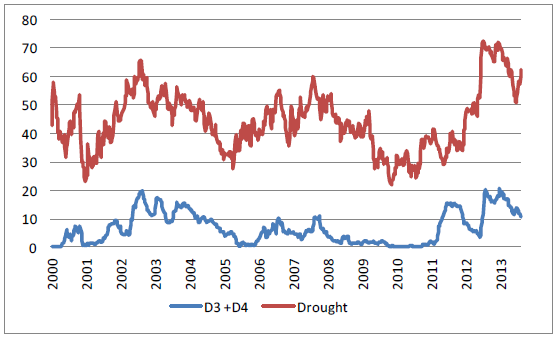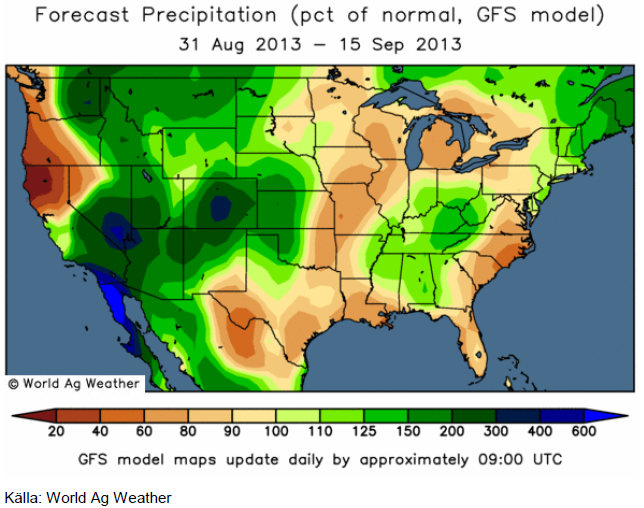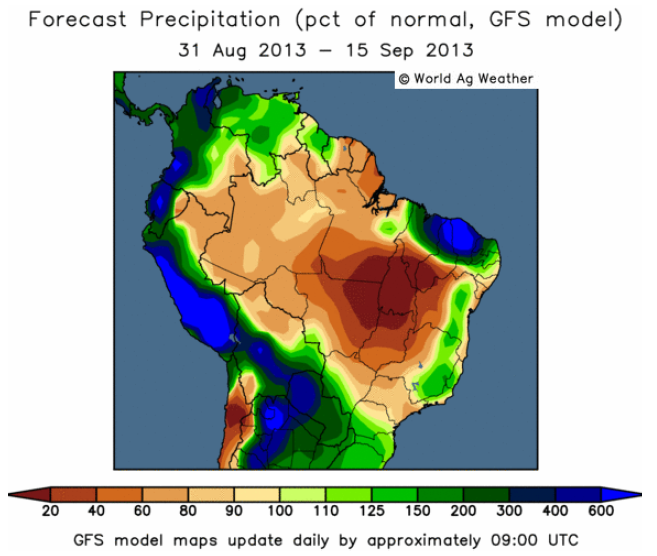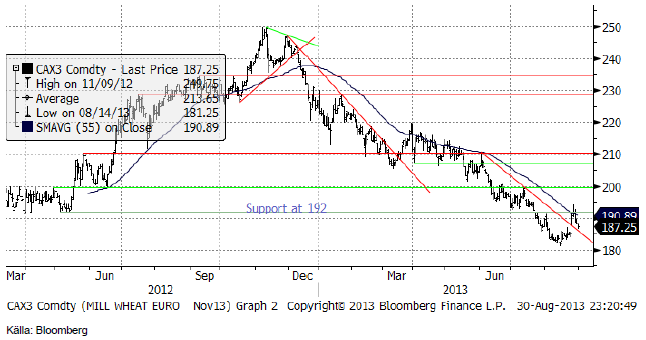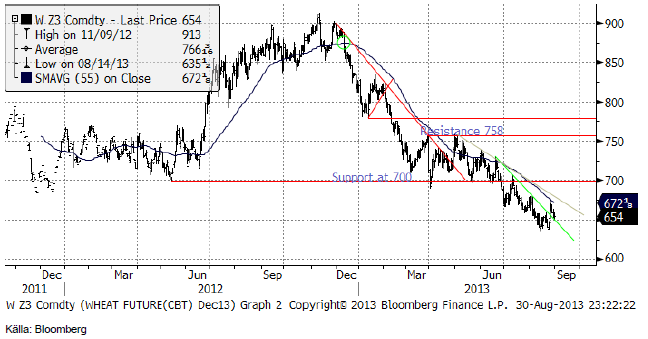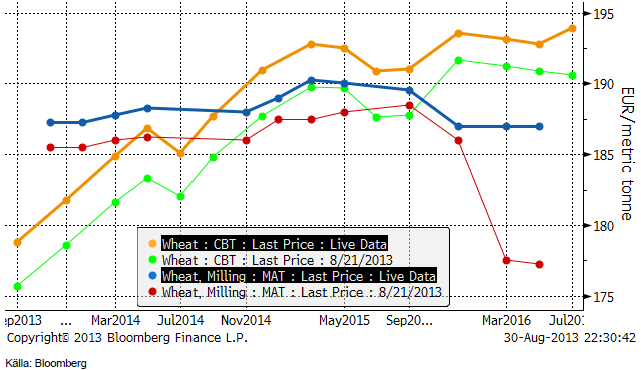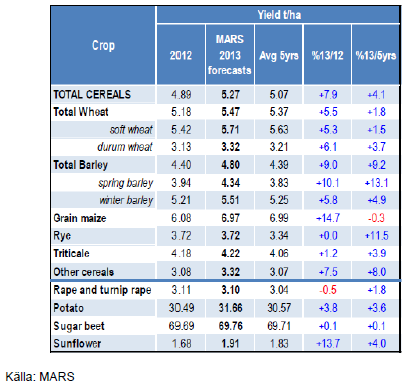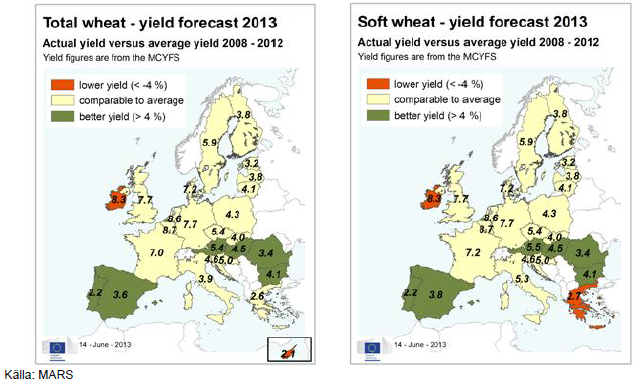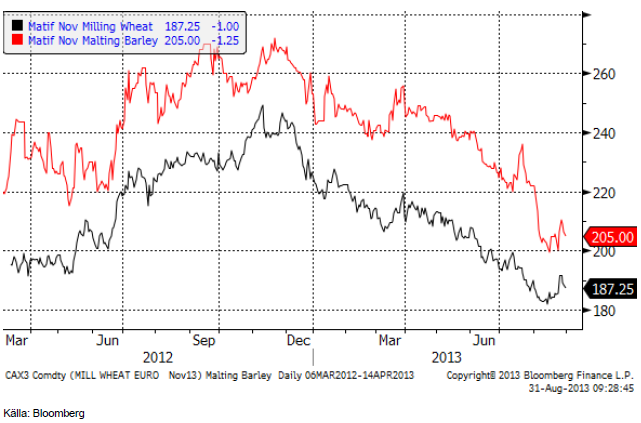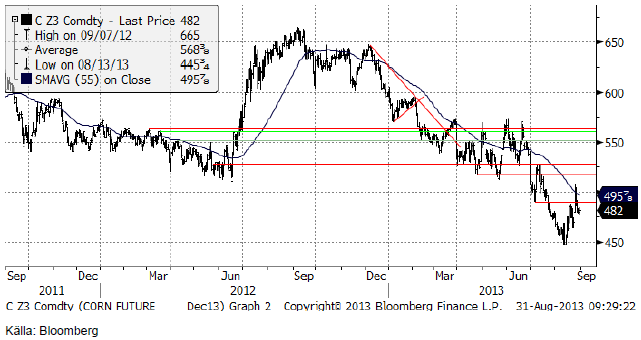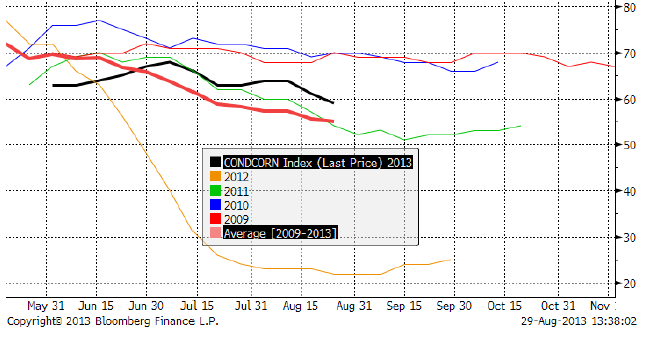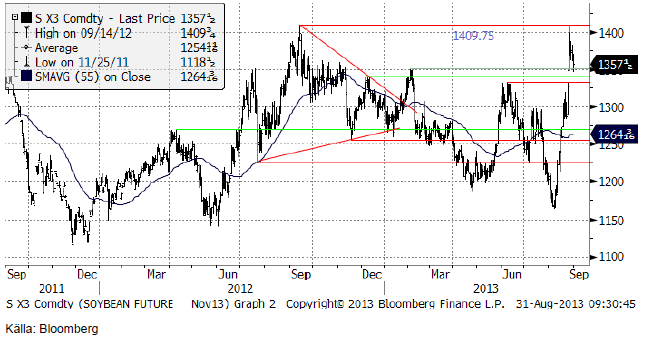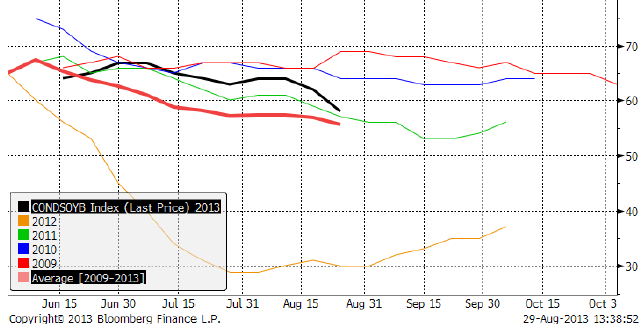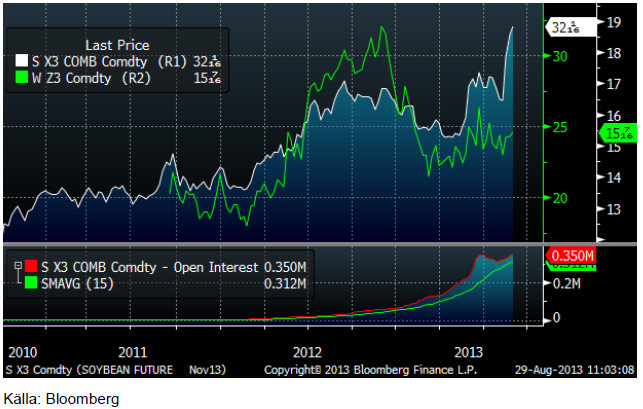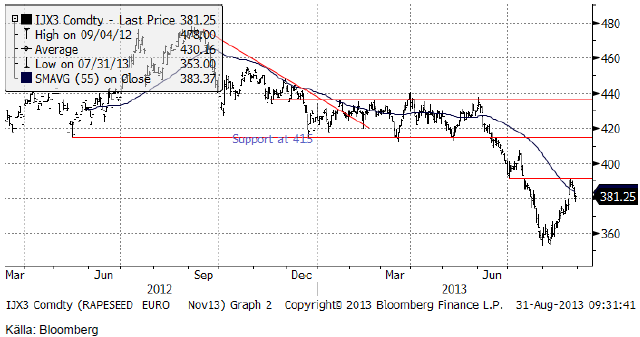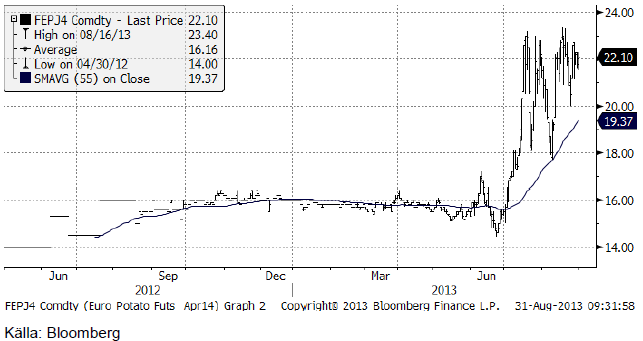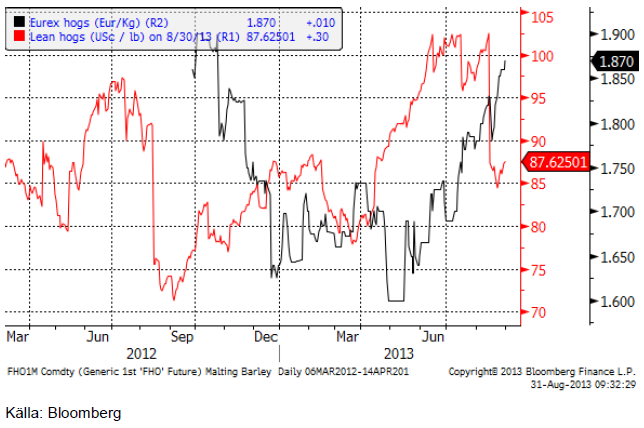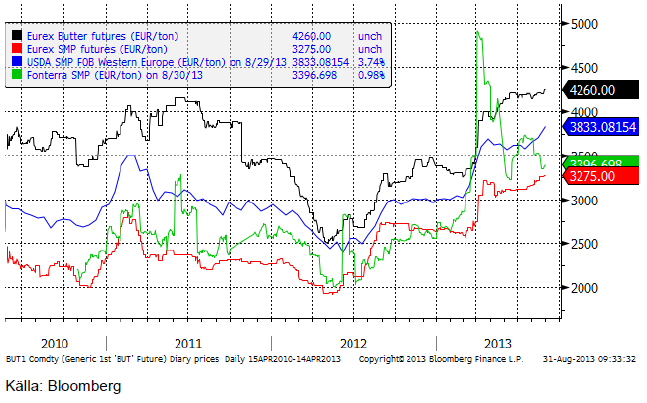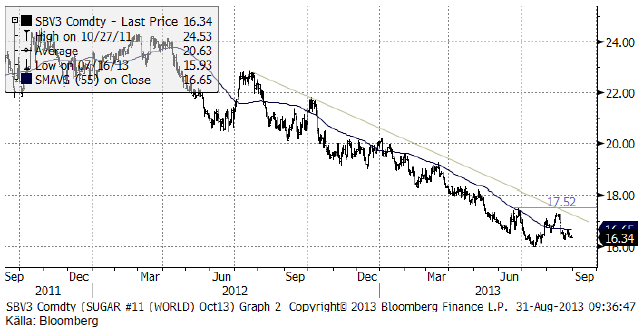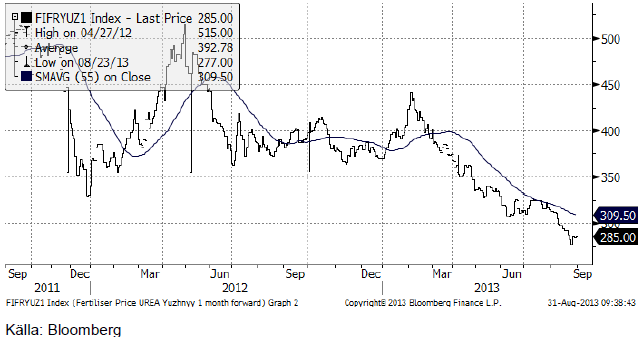Analys
SEB Jordbruksprodukter, 2 september 2013
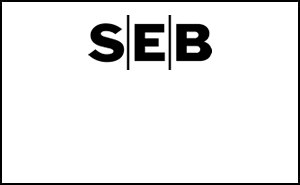
 Måndagen för en vecka sedan stod för veckans hela uppgång i priserna på jordbruksprodukter, med ledning av panikköpet i asiatisk handel av sojabönor. Därefter har priserna gått kräftgång. Väderleksprognosen för USA har svängt från hotfullt torrt till betydligt våtare än normalt. Sådden i Brasilien börjar den här veckan och pågår i september. Den fallande realen har stimulerat till en arealökning som bör ge ca 6 mt större skörd. Det finns förutsättningar för fortsatt prisfall, men vad händer sedan? Vi tror priserna går ner på oljeväxter, men är inte lika säkra, därför neutrala, på spannmål.
Måndagen för en vecka sedan stod för veckans hela uppgång i priserna på jordbruksprodukter, med ledning av panikköpet i asiatisk handel av sojabönor. Därefter har priserna gått kräftgång. Väderleksprognosen för USA har svängt från hotfullt torrt till betydligt våtare än normalt. Sådden i Brasilien börjar den här veckan och pågår i september. Den fallande realen har stimulerat till en arealökning som bör ge ca 6 mt större skörd. Det finns förutsättningar för fortsatt prisfall, men vad händer sedan? Vi tror priserna går ner på oljeväxter, men är inte lika säkra, därför neutrala, på spannmål.
Odlingsväder
US Drought Monitor rapporterar att per den 27 augusti hade andelen av USA som är torrare än normalt ökat till 62.3% av USA:s yta, från 60% veckan innan. Sedan den 2 juli har andelen ökat med 11 procentenheter från 51%. Nedan ser vi andelen av USA som är drabbat av torka. Den övre kurvan visar andelen som är drabbat av någon form av torka och den nedre visar den andel som är drabbat av de två värsta formerna av torka, ”extrem” och ”exceptionell”.
Nedan ser vi 15 dagars prognos för avvikelsen i nederbörd mot det normala i Nordamerika, enligt GFS-modellen. Om du jämför den här bilden med den i förra veckobrevet, ser du att det är väsentligt grönare (mer nederbörd) och betydligt mindre röda toner och där de finns är de väsentligt blekare. Detta är bearish soja och majs.
Sådden av sojabönor i Brasilien börjar nu och pågår i resten av månaden. Väderleksförhållandena är bra. Det väntas regna mindre än normalt i Centro Oeste, som vi ser i kartbilden nedan. Detta gör absolut ingenting, eftersom man inte odlar något där. Det är för torrt som det är. Vi ser att Mato Grosso och Paraná väntas få helt normalt väder under prognosperioden som sträcker till hälften av planteringsmånaden.
Jag fick en fråga tidigare i veckan varför Kina importerar så mycket vete just nu, trots att man inte sett några nyheter om att skörden skulle ha slagit fel. Möjligen kan ett nyhetsinslag på BBC den 19 augusti ge svar på det. Där rapporteras om att minst 105 personer har dött och 115 saknas efter översvämningar och härjningarna av en tyfon. Skyfall har orsakat översvämningar i de nordöstra provinserna Liaoning, Jilin och Heilongjiang. Dessa är Kinas kornbodar, där vete är den främsta grödan. Enligt kinas nyhetsbyrå Xinhua är översvämningarna de värsta på ”årtionden”. 265,000 hektar av skörden har förstörts, enligt Xinhua. I södra Kinas Guangdong-provins har 22 personer avlidit i härjningarna av tyfonen som fått namnet Utor. Skyfall i spåren av tyfonen har orsakat än mer skada, men det saknas uppgifter om skador på grödor. Skadorna i norra Kina, kan handla om ett produktionsbortfall på ett par miljoner ton.
Vete
November vetet på Matif bröt det tekniska motståndet i början på veckan, men föll sedan tillbaka. Uppgången började redan när Chicagomarknaden öppnade för veckan klockan 2 på morgonen svensk tid. Det är asiatisk handelstid. Sojabönorna handlades limit up på vad som såg att vara panikstängning av korta positioner. Asien är den största importregionen. Efter en sådan ”blow-out” är det vanligt att prisrörelsen stannar upp och det gjorde den också. När köpbehovet borta, för stunden i alla fall, kunde så priserna falla tillbaka. Tekniskt måste vi inse att vi trots allt har fått ett brott av trenden nedåt. Om det blir bestående återstår att se. Vi gick över till neutral rekommendation i förra veckans brev och vi behåller den.
Decemberkontraktet på CBOT stängde i fredags på 654 cent, vilket är en liten uppgång från förra veckans 646 cent per bushel.
Nedan ser vi terminskurvorna för Chicagovete och Matif-vete i fredags och veckan innan. Det är i princip parallellskift uppåt. Vi ser att Matif-terminerna med leveransdatum år 2016 har hamnat på rätt nivå. Som påpekades förra veckan, var priserna felaktigt under 185 euro per ton på börsen. Orsaken var att ingen handel skett i dessa kontrakt. Vi ser dock återigen, att det är bättre betalt för skörden i Chicagomarknaden än i Matifmarknaden.
EU Kommissionens MARS-enhet gjorde en marginell justering uppåt i sin senaste rapport gällande den genomsnittliga avkastningen för vete. Även för raps och korn gjordes justeringar uppåt medan avkastningen för majs justeras ner, framförallt till följd av en rejäl revidering nedåt för Ungern (från 6.94 t/ha till 5.05 t/ha) . Rapporteringsperioden har präglats av väderförhållanden med temperaturer över det normala samt nederbörd under det normala i stora delar av Europa. Torrt och varmt väder har framförallt påverkar vårgrödornas utveckling i norra Italien och delar av Ungern, Österrike, Slovenien och Kroatien. Utsikterna för EU-28’s spannmål är dock gynnsamma och estimeras väl över förra årets nivå och det femåriga genomsnittet.
Prognosen för hektarskörden avseende vete inom EU-28 justeras upp marginellt till 5.71 t/ha från förra månadens 5.69 t/ha, vilket är en ökning med 5.3% jämfört med förra året och över det femåriga genomsnittet på 5.63 t/ha. Detta återspeglar uppjusteringar av hektarskörden i Tjeckien, Bulgarien Rumänien och Österrike.
Måndagens Crop Progress från USDA visar att skörden av amerikanskt vårvete går framåt i rask takt. För de 6 stater som rapporterar så är nu 42% av skörden avklarad, en rejäl ökning från förra veckans 18% men något under det 5-åriga genomsnittet på 54% och väl under förra årets 87% vid den här tiden. 67% klassas som ”good/excellent”, en marginell ökning från förra veckans 66%.
Egypten har köpt ytterligare 295 000 ton vete för leverans i början av oktober. Fördelningen blev 60 000 t ryskt vete, 60 000 t rumänskt vete och resten från Ukraina. Det franska vete som offererades blev lätt utkonkurrerat av de aggressiva priserna från Svarta Havs-regionen, och inga offerter lämnades för amerikanskt vete.
Jämfört med förra veckan, är vi nu ännu mindre inställda på att ha säljrekommendation. Vi ser dock ingen anledning att köpa spannmål. Vi behåller, som ovan nämnt, alltså vår neutral-rekommendation.
Liksom förra veckan vill jag påminna om att det finns lantbrukare som nu tänker lagra sin spannmål i hopp om att kunna sälja den dyrare någon gång i vinter. I boken ”Bättre betalt för skörden – riskhantering för lantbrukare” har detta inte varit en framgångsrik strategi i sig, testat sedan 1980. Det är en framgångsrik strategi om det finns ett contango i Chicagomarknaden, som kan ge lönsamhet genom en så kallad ”cash-and-carry trade”. Man tjänar helt enkelt pengar på att terminspremien över spot i terminsmarknaden är större än finansierings- och lagringskostnaden för spannmålen. Det är en lågriskstrategi som i bästa fall ger en attraktiv ränteplacering.
Maltkorn
Maltkornet rekylerade uppåt samtidigt med vetet och oljeväxterna. För maltkornet fanns (och finns) ett starkt stöd vid 200 euro. Jämna siffror tenderar att attrahera köp-ordrar när priset kommer farande uppifrån.
Majs
Majspriset (december 2013) har stigit samtidigt som många andra råvaror gjort det, men rekylerade ner i veckan som gick. Allt torrare väder i USA, som har drabbat sojan, framförallt, har ändå haft en effekt på majspriset också. Det är för tidigt att avgöra om uppgången och den lilla rekylen nedåt förra veckan, är början på en ny vändning uppåt, eller bara en paus innan ytterligare prisfall. Vi skriver under sojabönsrubriken om att man i Brasilien ökar arealen sojabönor kraftigt. Till viss del sker detta på bekostnad av betesmark, men till viss del också på bekostnad av majsen.
Måndagens Crop Progress från USDA visade ett något försämrat tillstånd för den amerikanska majsen. För de 18 stater som rapporterar så klassas 59% som ”good/excellent”, ner 2% från veckan innan men väl över förra årets 22% (då torkan tog död på stor del av all majs) samt över det 5-åriga genomsnittet på 56%. Tittar vi tillbaka så kan vi se att tillståndet långsamt har försämrats sedan början på juli då 68% var klassat som ”good/excellent”. För de tre stora producenterna Iowa, Illinois och Indiana har ”good/excellent” justerats ner med 14%, 9% resp. 9% sedan den 7 juli.
70% av majsen har nått mognadsstadiet ”dough”, vilket är en ökning från förra veckans 52%. Förra året, när det rådde torka, låg siffran på 94% vid den här tiden – men det 5-åriga genomsnittet ligger på 79%.
Som nämnt ovan behåller vi alltså förra veckans neutral-rekommendation.
Sojabönor
När veckan började i måndags för en vecka sedan hade sojapriset redan handlats upp rejält i asiatisk handel. I Asien finns de stora sojakonsumenterna i världen och uppgången hade karaktären av ”blow out”, dvs panikköp av köpare som legat korta. Teknisk analys bevisade sitt värde igen. Uppgången stannade under det tekniska motståndet på 1409.75 cent, som skapades av toppen i september för ett år sedan. Uppgången i veckan vände på 1409.50. Därefter skedde en liten rekyl. Det tidigare motståndet på 1350 fungerar nu som ett stöd.
Sojamarknaden har oroat sig för att torkan i USA, som inträffat precis när plantorna sätter baljor, ska medföra en mindre skörd än väntat. Flera firmor har successivt sänkt sina skördeestimat och de senaste kommer att ge USA ytterst lite utgående lager.
Å andra sidan väntas Brasilien och resten av Sydamerika öka sin produktion så mycket att det mer än väl kompenserar för eventuell minskning i USA. Det är alltså en kortsiktig och USA-fokuserad brist, som avhjälps ett halvår senare av Brasilien.
Väderleksprognosen enligt GFS-modellen har som vi skrivit om ovan under odlingsväder, slagit om till betydligt mindre torrt / mer vått. Det är möjligt att detta kan trigga ett brott nedåt under stödet på 1350.
Måndagens Crop Progress från USDA visade att även tillståndet för sojabönor har försämrats. 58% klassas nu som ”good/excellent”, ner från förra veckans 62% men fortfarande över förra årets 30% och det 5-åriga genomsnittet på 56%. De stora producenterna har en blandad utveckling vad gäller tillståndet för grödorna. I Illinois och Indiana klassas 60% resp. 67% som ”good/excellent”, medan endast 45% av Iowas grödor och 54% av Minnesotas grödor tillhör denna kategori.
84% av grödorna har uppnått stadiet baljsättning, en ökning från förra veckans 72%. Förra året vid den här tiden låg siffran på 95% och det 5-åriga genomsnittet ligger på 90%. Den globala produktionen av sojabönor estimeras till 282.5 mt av Oil World, vilket är 1.7 mt lägre än tidigare estimat pga försämrade utsikter för grödorna i USA och Kanada.
Nu i september börjar sådden av sojabönor i Brasilien.
Nedan ser vi sojapriset (SX3) i BRL / bushel som blå linje. Jag har också lagt in vetepriset (WZ3) i BRL/bu, som jämförelse. För en brasiliansk bonde ser priset på soja verkligen ut som ”gefundenes Fressen” – i år igen.
I måndags publicerade den brasilianska konsultfirman AgRural sin första rapport för säsongen. De skriver att skörden 2013/14 kan öka med 6% till rekordhöga 89.1 mt om det blir normala klimatförhållanden. De skriver också att tidiga indikatorer visar att sojaarealen kommer att öka med 6% till 29.5 miljoner hektar. För den största sojaodlande delstaten, Mato Grosso, ökar arealen med 592,000 hektar. Det är lika mycket som den sammanlagda åkerarealen i Skåne, Blekinge och Halland.
AgRural skriver att uppgången av den amerikanska dollarn (kraschen i Brasiliens valuta) har motverkat prisnedgången i sojapriset i Chicago, vilket gör det ekonomiskt attraktivt att öka produktionen i Brasilien.
I Mato Grosso kommer den nya sojaarealen från betesareal. I södra Brasilien, såsom i Paraná, sker expansionen på bekostnad av majsarealen.
Under normala klimatförhållanden , skulle Brasilien vara bakom USA i soja produktionen hos 13 /14 av som uppskattas till över 90 miljoner ton .AgRural estimerar att sommarens majsskörd kommer att minska med 13% och odlas på 6.89 miljoner hektar.
Veckan innan rapporterade ett annat rådgivningsföretag, Safras & Mercado, sin första prognos på sojaskörden och de uppskattade produktionen 2013/14 till 88.17 mt, en ökning med 7% från årets produktion.
I onsdags publicerade den brasilianska firman Agroconsult publicerade en prognos för skörden 2013/14 i. Medan skörden i våras (2012/13) var 82 mt sojabönor, väntar sig Agroconsult att nästa skörd, i vinter blir 88 mt.
USDA:s senaste prognos, från början av augusti, ligger på 85 mt för Brasilien. Det kan komma uppjusteringar där.
Raps
Rapspriset följde med sojan upp i måndags för en vecka sedan. Vi hann få med det i veckobrevet och rekommenderade sälj. Resten av veckan föll priset. Vi tror att rekylen fortsätter ner, understödd av omslag i väderleksprognosen för USA till blötare väder, vilket kan få sojan på fall.
Förra veckan noterade vi att Stats Canada rapporterade en estimerad skörd av canola på 14.7 mt, vilket är en ökning med 22% från förra året.
Nya nyheter är att Oil World justerar upp sitt estimat för den globala produktionen av raps till rekordhöga 64.8 mt, en ökning med 1.3 mt från tidigare estimat. För den Europeiska Unionen beräknas produktionen att uppgå till 20.8 mt, en ökning med 6.8% från förra året som återspeglar högre skördar i Polen, Tjeckien och Rumänien. Oil World’s prognos för produktionen i Kanada ligger nu på 14.8 mt, en ökning med 6.5%.
Säljrekommendation på raps just nu alltså.
Potatis
Potatispriset har fortsätt att ligga vid 22 euro per 100 Kg på Eurexbörsen.
Gris
Eurexpriset har gått upp från 1.85 euro / Kg förra veckan till 1.87 euro / Kg i fredags. Lean hogs-kontraktet i Chicago har också vänt upp igen.
Mjölk
Terminerna på smör och skummjölkspulver vid Eurex-börsen har fortsatt att stiga i veckan som gick. Fonterras pris noterar också en liten uppgång. I Nya Zeeland tonas faran med botulism ner. USDAs europeiska SMP-notering visar också på en uppgång och bekräftar den positiva utvecklingen på Eurex terminsmarknad.
Foderpriserna har fortsatt att falla under sommaren, som vi sett ovan. I våras var bilden klar att de kommande åren kommer att innebära goda priser på mjölk och i synnerhet väsentligt lägre priser på proteinfoder och spannmål. Den här bilden har fortsatt att stärkas.
Socker
Oktoberkontraktet på råsocker fortsätter att ligga i rekyl. Det återstår att se om marknaden vill göra ett nytt test av motståndet – och ta första steget mot en trendvändning uppåt. Tills dess fortsätter vi med neutral rekommendation.
Gödsel
Förhandlingar pågår mellan Ryssland och Vitryssland om den fängslade VD:n för ryska Uralkali av vitrysk polis. Det har ännu inte hänt något med POT:s aktiekurs, varför vi inte tror att det kommit ut några nyheter om att kali-kartellen skulle återuppstå.
Nedan ser vi priset på urea FOB Yuzhnyy, 1 månads termin, i dollar / ton. Det är en liten prisuppgång i veckan.
[box]SEB Veckobrev Jordbruksprodukter är producerat av SEB Merchant Banking och publiceras i samarbete och med tillstånd på Råvarumarknaden.se[/box]
Disclaimer
The information in this document has been compiled by SEB Merchant Banking, a division within Skandinaviska Enskilda Banken AB (publ) (“SEB”).
Opinions contained in this report represent the bank’s present opinion only and are subject to change without notice. All information contained in this report has been compiled in good faith from sources believed to be reliable. However, no representation or warranty, expressed or implied, is made with respect to the completeness or accuracy of its contents and the information is not to be relied upon as authoritative. Anyone considering taking actions based upon the content of this document is urged to base his or her investment decisions upon such investigations as he or she deems necessary. This document is being provided as information only, and no specific actions are being solicited as a result of it; to the extent permitted by law, no liability whatsoever is accepted for any direct or consequential loss arising from use of this document or its contents.
About SEB
SEB is a public company incorporated in Stockholm, Sweden, with limited liability. It is a participant at major Nordic and other European Regulated Markets and Multilateral Trading Facilities (as well as some non-European equivalent markets) for trading in financial instruments, such as markets operated by NASDAQ OMX, NYSE Euronext, London Stock Exchange, Deutsche Börse, Swiss Exchanges, Turquoise and Chi-X. SEB is authorized and regulated by Finansinspektionen in Sweden; it is authorized and subject to limited regulation by the Financial Services Authority for the conduct of designated investment business in the UK, and is subject to the provisions of relevant regulators in all other jurisdictions where SEB conducts operations. SEB Merchant Banking. All rights reserved.
Analys
Tightening fundamentals – bullish inventories from DOE

The latest weekly report from the US DOE showed a substantial drawdown across key petroleum categories, adding more upside potential to the fundamental picture.

Commercial crude inventories (excl. SPR) fell by 5.8 million barrels, bringing total inventories down to 415.1 million barrels. Now sitting 11% below the five-year seasonal norm and placed in the lowest 2015-2022 range (see picture below).
Product inventories also tightened further last week. Gasoline inventories declined by 2.1 million barrels, with reductions seen in both finished gasoline and blending components. Current gasoline levels are about 3% below the five-year average for this time of year.
Among products, the most notable move came in diesel, where inventories dropped by almost 4.1 million barrels, deepening the deficit to around 20% below seasonal norms – continuing to underscore the persistent supply tightness in diesel markets.
The only area of inventory growth was in propane/propylene, which posted a significant 5.1-million-barrel build and now stands 9% above the five-year average.
Total commercial petroleum inventories (crude plus refined products) declined by 4.2 million barrels on the week, reinforcing the overall tightening of US crude and products.


Analys
Bombs to ”ceasefire” in hours – Brent below $70

A classic case of “buy the rumor, sell the news” played out in oil markets, as Brent crude has dropped sharply – down nearly USD 10 per barrel since yesterday evening – following Iran’s retaliatory strike on a U.S. air base in Qatar. The immediate reaction was: “That was it?” The strike followed a carefully calibrated, non-escalatory playbook, avoiding direct threats to energy infrastructure or disruption of shipping through the Strait of Hormuz – thus calming worst-case fears.

After Monday morning’s sharp spike to USD 81.4 per barrel, triggered by the U.S. bombing of Iranian nuclear facilities, oil prices drifted sideways in anticipation of a potential Iranian response. That response came with advance warning and caused limited physical damage. Early this morning, both the U.S. President and Iranian state media announced a ceasefire, effectively placing a lid on the immediate conflict risk – at least for now.
As a result, Brent crude has now fallen by a total of USD 12 from Monday’s peak, currently trading around USD 69 per barrel.
Looking beyond geopolitics, the market will now shift its focus to the upcoming OPEC+ meeting in early July. Saudi Arabia’s decision to increase output earlier this year – despite falling prices – has drawn renewed attention considering recent developments. Some suggest this was a response to U.S. pressure to offset potential Iranian supply losses.
However, consensus is that the move was driven more by internal OPEC+ dynamics. After years of curbing production to support prices, Riyadh had grown frustrated with quota-busting by several members (notably Kazakhstan). With Saudi Arabia cutting up to 2 million barrels per day – roughly 2% of global supply – returns were diminishing, and the risk of losing market share was rising. The production increase is widely seen as an effort to reassert leadership and restore discipline within the group.
That said, the FT recently stated that, the Saudis remain wary of past missteps. In 2018, Riyadh ramped up output at Trump’s request ahead of Iran sanctions, only to see prices collapse when the U.S. granted broad waivers – triggering oversupply. Officials have reportedly made it clear they don’t intend to repeat that mistake.
The recent visit by President Trump to Saudi Arabia, which included agreements on AI, defense, and nuclear cooperation, suggests a broader strategic alignment. This has fueled speculation about a quiet “pump-for-politics” deal behind recent production moves.
Looking ahead, oil prices have now retraced the entire rally sparked by the June 13 Israel–Iran escalation. This retreat provides more political and policy space for both the U.S. and Saudi Arabia. Specifically, it makes it easier for Riyadh to scale back its three recent production hikes of 411,000 barrels each, potentially returning to more moderate increases of 137,000 barrels for August and September.
In short: with no major loss of Iranian supply to the market, OPEC+ – led by Saudi Arabia – no longer needs to compensate for a disruption that hasn’t materialized, especially not to please the U.S. at the cost of its own market strategy. As the Saudis themselves have signaled, they are unlikely to repeat previous mistakes.
Conclusion: With Brent now in the high USD 60s, buying oil looks fundamentally justified. The geopolitical premium has deflated, but tensions between Israel and Iran remain unresolved – and the risk of missteps and renewed escalation still lingers. In fact, even this morning, reports have emerged of renewed missile fire despite the declared “truce.” The path forward may be calmer – but it is far from stable.
Analys
A muted price reaction. Market looks relaxed, but it is still on edge waiting for what Iran will do

Brent crossed the 80-line this morning but quickly fell back assigning limited probability for Iran choosing to close the Strait of Hormuz. Brent traded in a range of USD 70.56 – 79.04/b last week as the market fluctuated between ”Iran wants a deal” and ”US is about to attack Iran”. At the end of the week though, Donald Trump managed to convince markets (and probably also Iran) that he would make a decision within two weeks. I.e. no imminent attack. Previously when when he has talked about ”making a decision within two weeks” he has often ended up doing nothing in the end. The oil market relaxed as a result and the week ended at USD 77.01/b which is just USD 6/b above the year to date average of USD 71/b.

Brent jumped to USD 81.4/b this morning, the highest since mid-January, but then quickly fell back to a current price of USD 78.2/b which is only up 1.5% versus the close on Friday. As such the market is pricing a fairly low probability that Iran will actually close the Strait of Hormuz. Probably because it will hurt Iranian oil exports as well as the global oil market.
It was however all smoke and mirrors. Deception. The US attacked Iran on Saturday. The attack involved 125 warplanes, submarines and surface warships and 14 bunker buster bombs were dropped on Iranian nuclear sites including Fordow, Natanz and Isfahan. In response the Iranian Parliament voted in support of closing the Strait of Hormuz where some 17 mb of crude and products is transported to the global market every day plus significant volumes of LNG. This is however merely an advise to the Supreme leader Ayatollah Ali Khamenei and the Supreme National Security Council which sits with the final and actual decision.
No supply of oil is lost yet. It is about the risk of Iran closing the Strait of Hormuz or not. So far not a single drop of oil supply has been lost to the global market. The price at the moment is all about the assessed risk of loss of supply. Will Iran choose to choke of the Strait of Hormuz or not? That is the big question. It would be painful for US consumers, for Donald Trump’s voter base, for the global economy but also for Iran and its population which relies on oil exports and income from selling oil out of that Strait as well. As such it is not a no-brainer choice for Iran to close the Strait for oil exports. And looking at the il price this morning it is clear that the oil market doesn’t assign a very high probability of it happening. It is however probably well within the capability of Iran to close the Strait off with rockets, mines, air-drones and possibly sea-drones. Just look at how Ukraine has been able to control and damage the Russian Black Sea fleet.
What to do about the highly enriched uranium which has gone missing? While the US and Israel can celebrate their destruction of Iranian nuclear facilities they are also scratching their heads over what to do with the lost Iranian nuclear material. Iran had 408 kg of highly enriched uranium (IAEA). Almost weapons grade. Enough for some 10 nuclear warheads. It seems to have been transported out of Fordow before the attack this weekend.
The market is still on edge. USD 80-something/b seems sensible while we wait. The oil market reaction to this weekend’s events is very muted so far. The market is still on edge awaiting what Iran will do. Because Iran will do something. But what and when? An oil price of 80-something seems like a sensible level until something do happen.
-

 Nyheter3 veckor sedan
Nyheter3 veckor sedanStor uppsida i Lappland Guldprospekterings aktie enligt analys
-

 Nyheter4 veckor sedan
Nyheter4 veckor sedanBrookfield ska bygga ett AI-datacenter på hela 750 MW i Strängnäs
-

 Nyheter3 veckor sedan
Nyheter3 veckor sedanSilverpriset släpar efter guldets utveckling, har mer uppsida
-

 Nyheter4 veckor sedan
Nyheter4 veckor sedanTradingfirman XTX Markets bygger datacenter i finska Kajana för 1 miljard euro
-

 Nyheter2 veckor sedan
Nyheter2 veckor sedanUppgången i oljepriset planade ut under helgen
-

 Nyheter2 veckor sedan
Nyheter2 veckor sedanLåga elpriser i sommar – men mellersta Sverige får en ökning
-

 Analys2 veckor sedan
Analys2 veckor sedanVery relaxed at USD 75/b. Risk barometer will likely fluctuate to higher levels with Brent into the 80ies or higher coming 2-3 weeks
-

 Nyheter1 vecka sedan
Nyheter1 vecka sedanMahvie Minerals växlar spår – satsar fullt ut på guld


